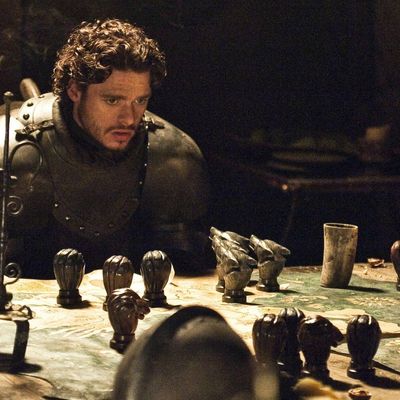
Game of Thrones just wrapped up its penultimate season, with reports that the final season might not air until 2019. If you’re staring at the Long Night in terror and need a GOT fix, you could wait for George R.R. Martin to finish the next book — ha! — or you could try one of these five GOT-themed board games, some of which do a good job of integrating aspects of the characters and stories into their mechanics … and some of which don’t.
Game of Thrones: The Board Game
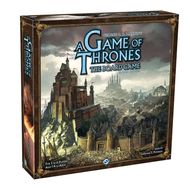
Cost: $56.98
Number of players: 3–6
Length of gameplay: 2–4 hours
My first rule of board games is that the enjoyment level offered by a game is inversely proportional to the length of its rule book. There are exceptions, of course, but as a general heuristic I find it’s pretty accurate. The Game of Thrones board game has a 28-page rule book, which I think qualifies it for the Best Novel category in the Hugo awards, and the rules are dense and too complicated in parts.
Set on a map of Westeros, the GOT board game pits 3 to 6 players against each other to fight for control of the various regions, with the first player to control seven areas with castles or strongholds the winner. (If no one gets there, the game ends, mercifully, after ten rounds.) With three players, everyone starts a little distance apart, so you might go three rounds without combat while everyone spread out, but with five or six players you’re going to smash into each other quickly. Each person starts with a unique setup tied to his/her House and a few units, but you get to muster new units in randomly determined rounds, based on the supplies offered by the areas you control. With more than three players, alliances can form more easily, and third-party players can offer support in combat that occurs adjacent to their forces, so negotiations become significant, whereas in a three-player game they’re less useful.
Ultimately, the game itself doesn’t need to be as difficult as its tome of a rule book would suggest. This is a Risk-plus area-control game with a bit of resource management thrown in, though the combat system slows things down too much, dragging players from “playing” into “accounting.” The Game of Thrones story and characters are moderately integrated into gameplay, particularly the map and settings themselves. Each player gets a deck of cards with characters on them to be used in combat, with abilities tied to the characters’ traits. But really, the show connection is much more a function of putting you into Westeros than incorporating any of the story or the personalities themselves.
A Game of Thrones: The Card Game
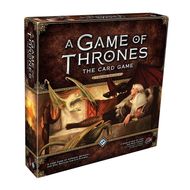
Cost: $31.91
Number of players: 2–6
Length of gameplay: 1–2 hours
This is both the best Game of Thrones–themed game on the market and the one that best integrates the content of the series into gameplay. This version of the game, first sold in 2015, is a Living Card Game™ , a specific style of deck-building game developed by Fantasy Flight. It’s similar to Magic: The Gathering but without the collectible aspect — in other words, there aren’t cards that are scarce and selling for hundreds of dollars on the secondary market, which I think takes M:TG way beyond a game into the kind of thing that causes knife fights. Fantasy Flight has a series of LCGs, which are “living” because the company regularly issues expansion packs of new cards, including Android: Netrunner, Star Wars: Destiny, and the big hit of 2017’s GenCon gaming convention, Legend of the Five Rings.
The GOT card game pits two to four players against each other, with each player starting with a deck that contains cards from two houses (in the base game — expansions will vary this). It’s particularly sharp as a two-player duel, although it does work with more players, just requiring more time to get to the victory condition. Each player builds a tableau of character cards, upgrading them with other cards that add weapons or special abilities, and uses them to attack the other player or to defend against attacks. In each round, players draw a “plot card” that sets some new ground rules, affecting income, powers, and thus strategy for the ensuing round. You can activate certain cards once per round to use their abilities but thus lose them for the remainder of the round.
The attacks, called “challenges,” are the meat of this and every other LCG I’ve ever played: To borrow a line from Arch Enemy, this is fucking war. Each card has values in one to three categories — military, intrigue, or power, and you can use any of those to fight a challenge, with the rewards differing by what type of challenge you win. If you lose a military challenge, you must kill off (remove) a character from your board. If you win a power challenge, you give a power token or several to the winning player — and you get a bonus token if you win any challenge unopposed. The first player to get 15 tokens wins, but it can take a while to get there, up to two hours, because of all of the back and forth involved.
The rules are a bit long too, but the game flows well once all players understand the guidelines, especially for challenges. I’ve seen this and other LCGs played by experienced players at tournaments, and turns happen fast. You’re also rarely if ever waiting long to do anything, because almost every player’s move is going to affect at least one opponent.
And this game really takes the writing of the books and show into account: Character cards and traits reflect those of the source material. Some characters have special abilities, such as Insight (Danaerys) or Stealth (Maester Wendamyr); some simply have abilities that match their written personae (Jaime Lannister, who will not “kneel” in a challenge). There’s also a fair amount of balancing the need to defend yourself against setting up an engine for repeated attacks to try to win the back and forth that dominates the game. If you’re afraid you’ll miss GOT while it’s off air, this is the game most likely to give you the fix you want.
Game of Thrones: The Iron Throne
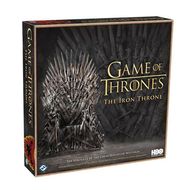
Cost: $42.95
Number of players: 3–5
Length of gameplay: 30–60 minutes
This game focuses on the alliances and betrayals of the series, as each player represents one house and will engage in “encounters” with other houses that can lead to temporary alliances, deaths, exchanges of influences, or a figurative knife in your back.
On your turn, you draw an event card to see which opponent you’ll face, then each of you chooses one of your characters to participate in the encounter. Every other player gets the chance to offer one of his/her characters as support to either side — so making alliances can be critical — while the two active players can negotiate and discuss whether they’re playing Hostility cards or Truce cards. If both play Hostility cards, the players add up the points on their side — their played cards, their played character values, and the added values of any supporting characters — and the larger total wins, with the winning player placing an influence token on the losing player’s board and then taking a card as a “hostage” from the loser. The players can agree to both play Truce cards, but something has to change hands in the process, such as one player agreeing to give power tokens to the other, or one player placing an influence token on the other’s board without hostilities. Someone can lie, however, in a Betrayal action, playing a Hostility card after they’ve both agreed to a truce. That player wins the encounter with the usual spoils, except this time, the losing player gets to take a hostage card from the winning player.
Play continues until one player has placed all five of his/her influence tokens on other players’ boards, or until all four of one player’s characters are killed (losing all power tokens on each card). Whoever has the most influence on others’ boards is the winner.
If any of this sounds familiar to the old-timey gamers among you, that’s because The Iron Throne is built on the framework of the classic game Cosmic Encounter, first released in 1977 and reissued multiple times over the last four decades. Some core mechanics are the same, with a new skin and character abilities tied somewhat to the GOT canon. The Tyrell House cards tend towards spiteful actions, depriving winners of rewards or allowing the Tyrell player to withdraw from an encounter and still gain some of the spoils. The Lannister cards intensify conflicts by raising hostilities or removing power tokens from opposing characters. The Stark cards are more strategic, involving hand management, moving power tokens, or forcing an opponent to release all of your cards held as hostages. House Baratheon cards ramp up conflicts in unpredictable ways, while Targaryen cards make your side more powerful in hostilities.
The base game plays three to five, but with three players it’s kind of pointless — two players can form an alliance and knock the third one out or just weaken him to make it a two-player contest. Because of the high social interaction component, it works better with more players, and this year’s expansion, The Wars to Come, increases the player count to seven, which coincidentally is the same number of players as you need for Diplomacy, the original and still classic game of alliances, betrayals, and hurt feelings. If you have a larger group of players than the card game can accommodate and/or want a quicker game, this is the better bet.
A Game of Thrones: Hand of the King
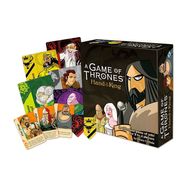
Cost: $17.49
Number of players: 2–4
Length of gameplay: 15–30 minutes
This quick, color-matching game has almost nothing at all to with the show or books, and it’s fun but kind of a trifle. Designed by Bruno Cathala, who won this year’s Spiel des Jahres award for his game Kingdomino and co-designed the games 7 Wonders Duel and Yamatai, Hand of the King has players lay out a 36-card, six-by-six grid that contains character cards of six different colors, representing the six Houses, plus one neutral card with the character Varys. Players then move Varys in any orthogonal direction and take all cards in that direction belonging to one specific house. Each house has a different number of cards in its set (7, 6, 5, 4, 3, 2), and the player with the majority of cards in a house gets its banner, with the winner going to the player with the most banners. Simply catching the leader of cards in a house gets you the banner, so if you get the second of the two Tully character cards, you get the banner.
If you take the last character on the board belonging to a specific house, you can choose one of the six “companion” cards, representing side characters from the stories who don’t belong to any houses. (Hodor). Each companion card lets you take a special action, from getting an extra turn to stealing a card from another player to taking a card from the grid and removing it entirely from the game. That’s as much Game of Thrones content as you’ll get in this game, which is really about collecting sets and trying to think a move or two ahead.
Game of Thrones: Westeros Intrigue
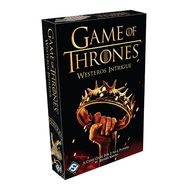
Cost: $12.09
Number of players: 2–6
Length of gameplay: 15–30 minutes
This is the real oddball of the bunch, as prolific designer Reiner Knizia — among whose 400-plus titles are Tigris & Euphrates, Ra, Samurai, and the new Quest for El Dorado — rethemed his kids’ game Penguin with Game of Thrones artwork. It’s a peculiar choice, as Penguin is considered one of Knizia’s worst designs; of all of his games ranked on Boardgamegeek, it is the lowest, at No. 14,083 overall. (If you’re morbidly curious: Of the more than 14,000 games ranked on the site, the bottom three are Candyland, Snakes & Ladders, and Tic-Tac-Toe.)
Each player starts the game with a hand of between 6 and 14 cards, depending on the number of players, and players go around placing cards on the table, building a pyramid of cards, placing cards next to any other card as long as they don’t exceed the card limit for that row, or placing a card of a certain House (color) above any other card of the same House. If you can’t legally place a card, you’re eliminated from the round; the last player to make a legal placement gets a bonus. That’s it — there couldn’t be any less GOT content in here, and you could play the same game with a deck of cards in five different colors. No matter how much you love the Thrones, don’t waste your time.




